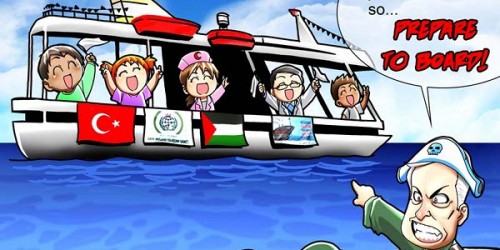
By: Yousef Munayyer
In recent days, coverage of the attack on the aid flotilla headed to the Gaza Strip has focused on the lack of availability of certain humanitarian goods. This fact sheet is a reference tool based on international aid agencies and human rights groups on the impact of the siege on the population of Gaza.
Electricity: The siege has led to a significant lack of power in the Gaza Strip. In 2006, Israel carried out an attack on Gaza’s only power plant and never permitted the rebuilding to its pre-attack capacity (down to producing 80 megawatts maximum from 140 megawatts). According to the UN Office for the Coordination of Humanitarian Affairs (UN OCHA), the daily electricity deficit has increased since January of 2010 with the plant only able to operate one turbine producing only 30 megawatts compared to its previous average of 60-65 megawatts in 2009. The majority of houses have power cuts at least eight hours per day. Some have no electricity for long as 12 hours a day. The lack of electricity has led to reliance on generators, many of which have exploded from overwork, killing and maiming civilians. Oxfam reported that “[in 2009], a total of 75 Palestinians died from carbon monoxide gas poisoning or fires from generators, and 15 died and 27 people were injured in the first two months of this year.” Water: Israel has not permitted supplies into the Gaza Strip to rebuild the sewage system. Amnesty International reports that 90-95 percent of the drinking water in Gaza is contaminated and unfit for consumption. The United Nations even found that bottled water in Gaza contained contaminants, likely due to the plastic bottles recycled in dysfunctional factories. The lack of sufficient power for desalination and sewage facilities results in significant amounts of sewage seeping into Gaza’s costal aquifer–the main source of water for the people of Gaza.
Industry: Prior to the siege, the industrial sector employed 20 percent of Gaza’s labor force. One year after the siege began, the Palestinian Federation of Industries reported that “61% of the factories have completely closed down. 1% was forced to change their scope of work in order to meet their living expenses, 38% were partially closed (sometimes means they operate with less than 15% capacity)”. A World Health Organization report from this year states: “In the Gaza Strip, private enterprise is practically at a standstill as a consequence of the blockade. Almost all (98%) industrial operations have been shut down. The construction sector, which before September 2000 provided 15% of all jobs, has effectively halted. Only 258 industrial establishments in Gaza were operational in 2009 compared with over 2400 in 2006. As a result, unemployment rates have soared to 42% (up from 32% before the blockade).”
Health: Gaza’s health sector, dramatically overworked, was also significantly damaged by Operation Cast Lead. According to UN OCHA, infrastructure for 15 of 27 of Gaza’s hospitals, 43 of 110 of its primary care facilities, and 29 of its 148 ambulances were damaged or destroyed during the war. Without rebuilding materials like cement and glass due to Israeli restrictions, the vast majority of the destroyed health infrastructure has not been rebuilt. Many medical procedures for advanced illnesses are not available in Gaza. 1103 individuals applied for permits to exit the Israeli-controlled Erez crossing for medical treatment in 2009. 21 percent of these permits were denied or delayed resulting in missed hospital appointments, and several have died waiting to leave Gaza for treatment.
Food: A 2010 World Health Organization report stated that “chronic malnutrition in the Gaza Strip has risen over the past few years and has now reached 10.2%. Micronutrient deficiencies among children and women have reached levels that are of concern.” According to UN OCHA: “Over 60 percent of households are now food insecure, threatening the health and wellbeing of children, women and men. In this context, agriculture offers some practical solutions to a humanitarian problem. However, Israel’s import and access restrictions continue to suffocate the agriculture sector and directly contribute to rising food insecurity. Of particular concern, farmers and fishers’ lives are regularly put at risk, due to Israel’s enforcement of its access restrictions. The fact that this coastal population now imports fish from Israel and through tunnels under the Gaza-Egypt border speaks to the absurdity of the situation.” 72 percent of Gaza’s fish profit comes from beyond the three nautical mile mark, but further restrictions by Israel’s naval blockade prevents Gazans from fishing beyond that mark. Between 2008 and 2009 the fishing catch was down 47 percent.
* Yousef Munayyer is the Executive Director of the Jerusalem Fund and the Palestine Center.
